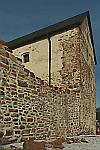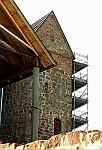|

All pictures are copyright by Gary Martens, All rights reserved.
Click on image to see larger version
 |
Kastelholm
towers up on a rocky cap. The name Kastelholm appears for the
first
time in 1388. The oldest part of the castle, the stronghold, was
built at the top of the rocky rise. The tallest part of the structure
is a gate tower, which was thought to have been built at the
end of the 13th century, at the time when the parish churches
in
Äland where being rebuilt. The plan of Kastelholm Castle is
typical of Saxon fortresses, which made full use of the nature
of
the terrain for encircling walls, and for grouping the buildings
inside it. |
 |
The strong
hold consists of the palace (dwelling house), an inner courtyard
and keep, and an entrance to the outer courtyard. The entrance was
accessible only with the aid of a ladder or wooden staircase, which
could be pulled up if enemies entered the yard. The gateway entrance
included a drawbridge, and was first mentioned in 1543, when it
was being repaired. The wall surfaces were plastered smooth and
whitewashed. The walls of the royal chambers were pannelled in the
lower parts, and the upper parts were hung with tapestries. |
 |
The southern
part of the stronghold consisted of an impregnable rock fort, resembling
those by by the Crusaders in Syria and Palestine An encirling wall
built around the outer courtyard on the northern part of the island,
also encloses the eastern part with the well. The wall is more than
two meters thick. |
 |
The outer
wall of the Castle is on the left, the inner castle on the right.
You can see evidence of many changes to the castle during the hundreds
of years that it has existed. The southern house shown here was
probably built by Duke John, who had received Äland in fieff
from his father Gustavus Wasa in 1556.. |
 |
The palace consists of a two room building of three storys, typical
of medieval castles. The bottom floor consisted of two basements
with a wooden ceiling resting on thick beams The vaults of the
ceiling are unhewn stone. The Äland churches have similar vaults,
indicating the same master builder was involved in building churches
in Äland. The body of the building had no interior staircases
or doors. Doors to the storys were on outer walls, and were built
between the 12th and 13th centuries.
|
Return to the Castles
Page
© 1999-2008, Gary Martens, All Rights Reserved -- This page last
modified: Friday, 7 November 2008
|

